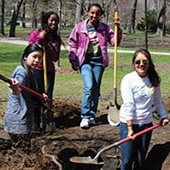The grass really is greener at NU
 Spring has sprung, and NU’s beautiful outdoor scenery is in bloom. It isn’t all pretty flowers and trees though; environmentally conscious practices are at the root of NU’s outdoor landscaping.
Spring has sprung, and NU’s beautiful outdoor scenery is in bloom. It isn’t all pretty flowers and trees though; environmentally conscious practices are at the root of NU’s outdoor landscaping.
A lot of thought goes into campus landscaping, including selection of plant species and placement. Trees and plants are specifically chosen to be resistant to diseases and pests. NU uses horticulture and plant husbandry techniques when planting to diversify species, ensuring the landscape is less susceptible to invasive diseases and insects. Facilities Management (FM) also pays special attention to campus climate. The weather near the lakefill varies from the temperature and climate near Deering Meadow, and specific species are planted based on these differences. All these techniques give NU’s plants the best chance for survival. And with all of the construction on campus, FM is doing their part to maintain the natural beauty of the campus and save vegetation at construction sites by transplanting plants and trees to alternative locations.
Conserving water and reducing storm runoff is another priority at NU. Water is recycled in creative ways through bioswales, green roofs, and daisy basins. Bioswales are landscaping mechanisms that use terracing to naturally draw water to specific locations. Northwestern has bioswales near the athletic fields and parking lots to move water to plants that need it. Green Roofs, which minimize stormwater runoff, are found at the Wild Roots Garden on the Norris University Center South Lawn and at the Ford Motor Company Engineering Design Center. Daisy basins are fixtures unique to Northwestern that divert also stormwater runoff. Though most of them are underground, some older daisy basins are visible above ground near Norris.
Other efforts to conserve water include a myriad of technologies such as solar clocks, rain gauges, and moisture sensors that calculate air moisture to determine when it will rain to avoid wasting water, time, and energy.
While maintaining our grounds, NU tries its best to avoid using harmful chemicals and employs Integrated Pest Management (IPM) to combat pests and weeds. This program involves researching the invasive pest or plant and coming up with ways to solve the problem with chemicals as the last resort. Some methods involve cultivating more grass to crowd out invasive plants, handpicking weeds, introducing predators like nematodes, or pruning dead wood to prevent insect invasion. By using these pest control techniques, the university uses minimal chemicals in their landscaping. The University is also experimenting with “no mow” grass near Harris Hall to reduce its use of fossil fuels in weekly mowings. The “no mow” grass only requires mowing once a year.
As we get into the warmer months, people are drawn outdoors to take a walk, admire the Wild Roots Garden, or read on the lakefill. When you do, take a moment to appreciate the effort that goes in to creating the sustainable and beautiful green spaces at NU.